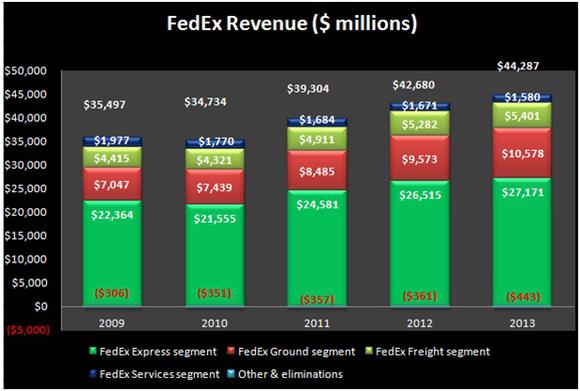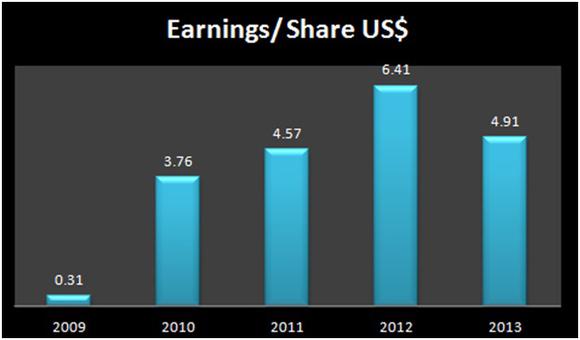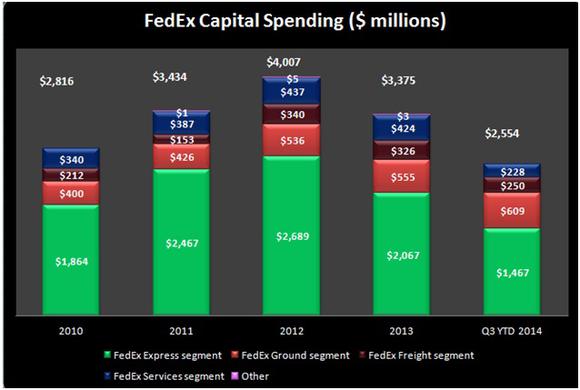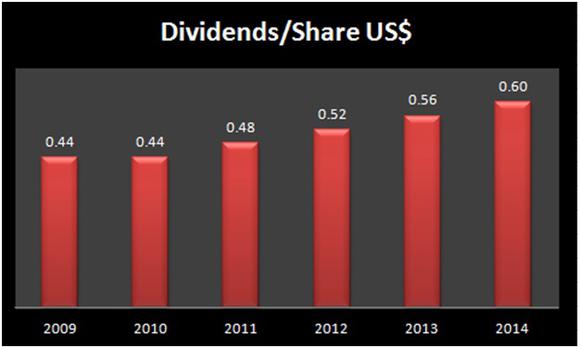When America's second-largest courier company, FedEx (FDX +1.41%), came out with its third-quarter numbers, the results didn't satisfy the Street. Despite the recent disappointment, can FedEx yet add value to your portfolio? Let's look at five key metrics related to growth, cash generation, return on invested capital (ROIC), cash returns to shareholders, and balance sheet strength to find out how the company fares on each account. The results could help us find the answer.
Revenue and earnings growth
FedEx's revenue growth has been modest in the recent past as shipment volumes have stagnated in the core Express segment. International priority business has witnessed steady declines, while U.S. packages saw flattish trends. To its credit, FedEx has grown shipment volumes in the Ground segment both in core operations as well as in FedEx SmartPost that compensated for some of the weakness in Express.
The company's five-year average top-line growth was 3.14% at the end of fiscal 2013 and has remained at 3% in the first three quarters of fiscal 2014 that ends in May. Analysts are expecting 2.5% revenue growth for the full year. However, FedEx has some good growth drivers, the biggest being the growing popularity of e-commerce that will keep the momentum going in the Ground segment. Consensus estimates show a 4.8% company-wide revenue growth in fiscal 2015.

Source: FedEx Stat Books
After the stagnation in 2009, FedEx has slowly improved its earnings over the past few years. Though there was a dip in 2013 owing to poor margins in Express, analysts are expecting earnings per share of $6.23 in fiscal 2014 and $6.68 in fiscal 2015 as the company starts benefiting from its ongoing cost-cutting program. FedEx is trying to save $1.6 billion operating costs in the Express segment and an additional $10 million elsewhere.

Source: Data from Morningstar; chart made by author
Cash generation
Investors always like to keep an eye on free cash flows as it is from this pool that dividends are dispersed, shares are bought back, and new investments are made. FedEx is generating free cash flows with more regularity of late. In fiscal 2013, it produced more than $1.3 billion free cash, a far cry from the $294 million in 2009.
It's encouraging that not only has the free cash flow grown in absolute terms, there has also been a steady improvement in free cash generation per revenue dollar. The company's converting a greater portion of its net income into free cash with comforting consistency.

Source: Data from Morningstar; chart made by author
Return on invested capital
The next thing to see is the kind of returns FedEx is generating on its new investments. In order to be accretive to shareholders, the ROIC has to exceed the company's weighted average cost of capital, or WACC. Most of the time, the company has been able to maintain a spread between the two; this means that it's invested in opportunities and assets that have created value for the shareholders.

Source: FedEx Roadshow presentation April 2014
Express being the largest business arm, FedEx would put most of its capital funds in it. Of late, however, returns have been low as margins are shrinking. As such, the company has started spending more on assets in the Ground segment where returns are higher. At the end of fiscal 2013, the Ground segment had an ROIC as high as 18%.
In the year-end conference call, CFO Alan Graf said the company will step up spending in the Ground segment so that it "can be ready for what traffics we are expecting in FY16, and I think it's a good thing. These are high ROIC investments and we are happy to put it in." Management has stayed true to its words as evident from the company's capital spending trend in the first three quarters of fiscal 2014.

Source: FedEx Stat Books
Returning cash to shareholders
FedEx is paying a quarterly dividend of $0.15 per share to its shareholders, and management tries to increase it annually. Since the payout ratio is a modest 11.4%, dividends are reasonably easy to sustain given the recent cash generation trends and the earning upsides that FedEx could see in the next few years.

Source: Data from Morningstar; chart made by author
The company has not restricted itself to dividends alone, as it has repurchased shares periodically. In the third quarter, management entered into accelerated share repurchase agreements to buyback $2 billion worth of shares.
Balance sheet strength
To form an idea about FedEx's balance sheet strength let's pick two important ratios: debt-to-equity ratio (total debt divided by shareholder's equity) and current ratio (current assets divided by current liabilities.)
FedEx maintains a good balance between its owned and borrowed funds -- its debt-to-equity ratio is just 16%. Anything that's lower than 30% is generally considered good.
Current ratio gauges whether the company has sufficient liquidity to meet its near-term operating requirements and anything above 1.5 is considered sufficient. FedEx passes this test too with a current ratio of 1.96.
Final take
FedEx has registered modest revenue and earnings growth in the past, but the story is changing as the company concentrates more on its profitable Ground segment and cuts costs. The courier giant is generating more and more cash, which could fund capital spending in the Ground segment and provide shareholder rewards like dividends and buybacks. Its balance sheet is in good shape with no liquidity concerns, and therefore looks to be a company with five solid reasons backing it as a worthy of consideration for an investor's portfolio.
